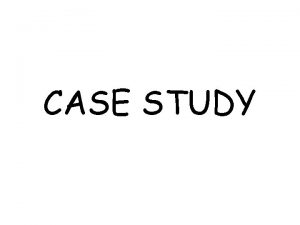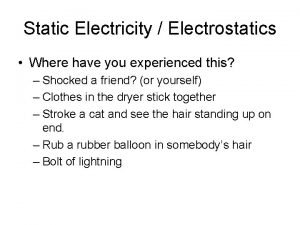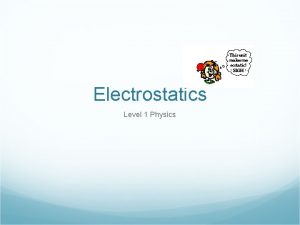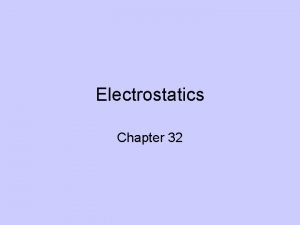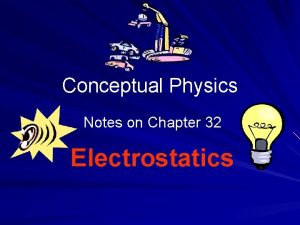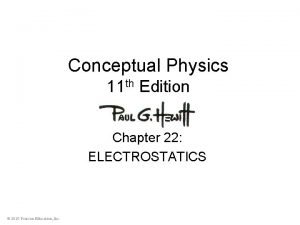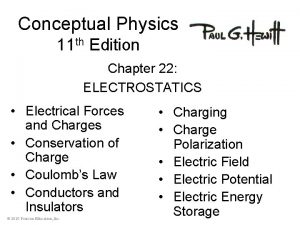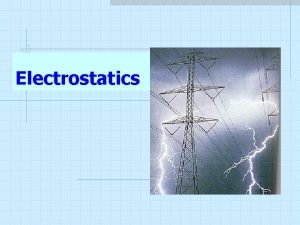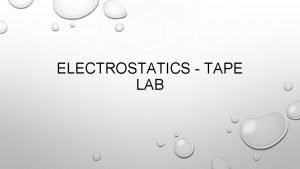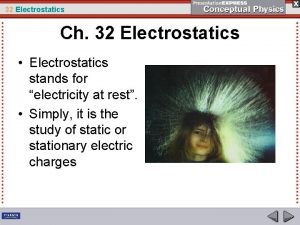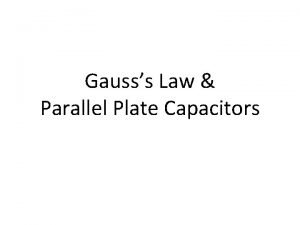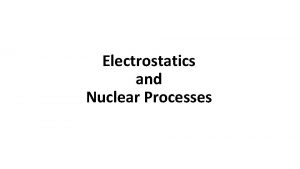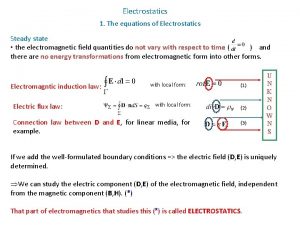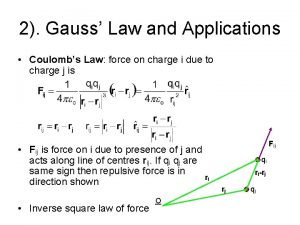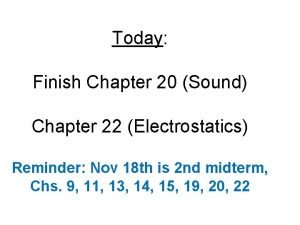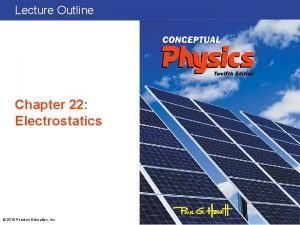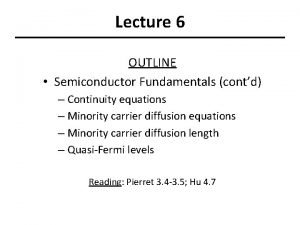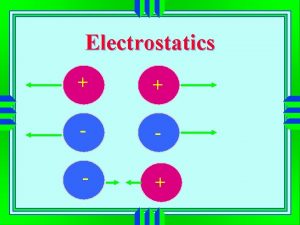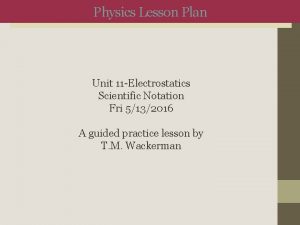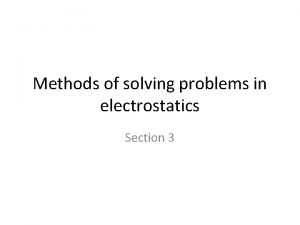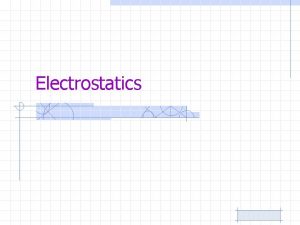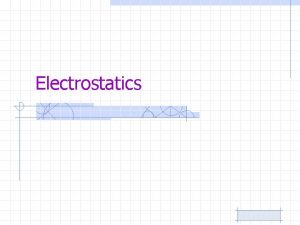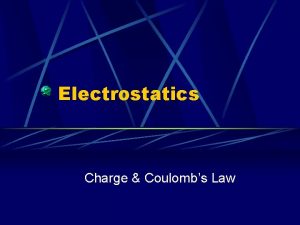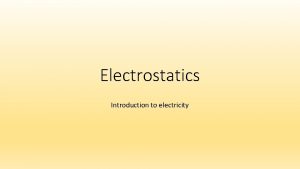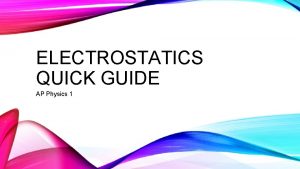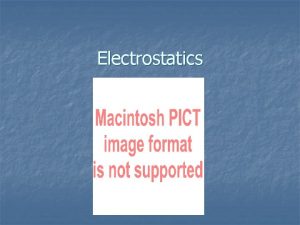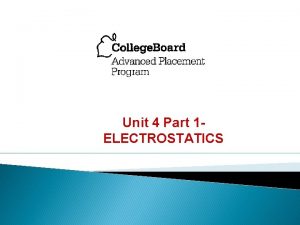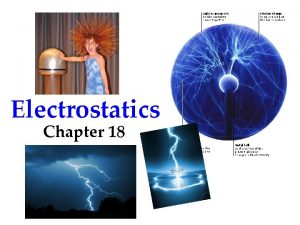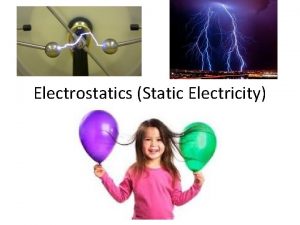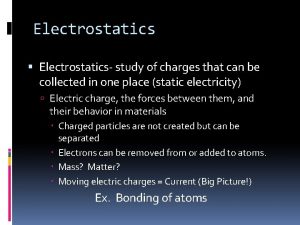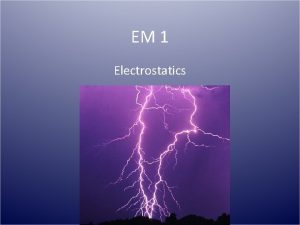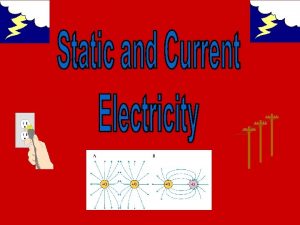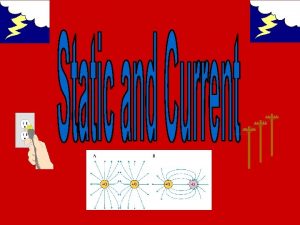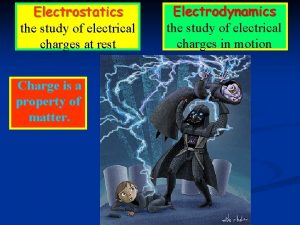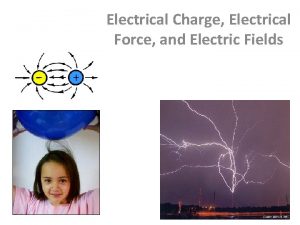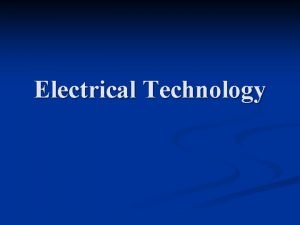Electrostatics Electrostatics Electrostatics is the study of electrical
























- Slides: 24

Electrostatics

Electrostatics • Electrostatics is the study of electrical charges at rest; i. e. , charged objects that are stationary or in a fixed position.

Charged and Uncharged Objects • Neutral Object: An object that has neither an excess nor a deficiency of electrons. • # of electrons = # of protons • Charged Object: An object with an excess or deficiency of electrons. Positive + - + + Negative

Elementary Charge (e) • What is the charge of an electron? • • What is the charge of a proton? • • -1. 6 x 10 -19 Coulombs (C) +1. 6 x 10 -19 Coulombs (C) The magnitude of the charge of the electron is equal and opposite that of the proton. • Note: In physics, the charge of an electron is NOT +1 or – 1!

Example #1 • An object has three excess electrons. – What is its “fundamental charge”? -3 fundamental (or elementary) charges – What is its charge in coulombs? q = 3 x (-1. 6 x 10 -19 C) = -4. 8 x 10 -19 C Note: - “fundamental charge” = elementary charge - “q” is the variable letter used for CHARGE

Example #2 • An object has 75 protons and 65 electrons – What is its “fundamental charge”? +10 fundamental charges – What is its charge in coulombs? q = 10 x (+1. 6 x 10 -19 C) = +1. 6 x 10 -18 C Note: You CANNOT have fractions of the elementary charge, e. g. ½ of e or 0. 8 x 10 -19 C

Law of Conservation of Charge • The total amount of charge in a closed system remains constant – charge is not created or destroyed, it only moves from one object to another • Charge “moves” as a result of ELECTRON movement ONLY!!!

Rubber and Wool/Glass and Silk • Rubbing a rubber rod with a piece of wool: The rod will pull the electrons off the wool, so that the rubber rod will end up with a net negative charge and the wool will have a net positive charge. • Rubbing a glass rod with a piece of silk: The silk will pull the electrons off the glass, so that the glass rod will end up with a net positive charge and the silk will have a net negative charge.

Conductors and Insulators • Conductors: Materials that allow for the free flow of electrons. – The best conductors come from the transitional elements of the periodic table. – The characteristics of the d orbitals permit electrons to flow freely because at least one electron is not held tightly by the nucleus. • Insulators: Materials that do not allow electrons to flow freely.

Forces of Attraction and Repulsion • In nature there are three principle forces – gravity, electromagnetic and nuclear (strong & weak). – Electromagnetic: • Attractive Forces: Opposite charges attract one another. A positively charged object will be attracted to a negatively charged object and vice versa. • Repulsive Forces: Like charges repel. Two positively charged objects or two negatively charged objects in proximity to one another will experience a repulsive force.

How do Objects Become Charged? • Conduction: Through direct contact. • Friction: Separation of Charge. • Induction: Without direct contact.

Charge by Conduction • Electrons flow from a charged object to an uncharged object through contact.

Charge Distribution • Conductors: Excess charges will maximize the space between them, which means that they will reside on the surface of the object with a uniform distribution. • Insulators: Excess charges will be located largely where they were transferred to the material.

Charge Distribution • One of these isolated charged spheres is copper and the other is rubber. The diagram below depicts the distribution of - charge over the surface of two spheres. Which one is rubber and which one is copper? Rubber Copper

Example #3 • Two charge spheres are brought into contact with one another and then separated. One of the spheres has a charge of -5 C while the other has a charge of +8 C prior to them being brought into contact with one another. – What is the total charge of the system? – What is the charge on each of the spheres afterwards? – How many elementary charges would have to be added or subtracted from each sphere to make them neutral? + + + + + _ _ _ + _ _ _ _

Example 3, cont. : • Applying the law of conservation of charge, the total charge of the system of charges must remain constant. – +8 C + -5 C = 3 C – Since there are only two spheres, the charge will be equally distributed over the surface of the two spheres. Consequently, each sphere will have +1. 5 C of charge. _ _ ++ ++ + + ++ _ _ + + + _+ ++ + _+_ ++ + +_ ++ _+ ++ +_ + + _ _ _ + + _+ _ _ + ++ _++ + _ _ + + _+ +_ + + _ _++ _+ + + _ __ _ _ + + __ _ __

Example 3, cont. : • There are two ways of finding the number of elementary charges that would have to be added or subtracted from each sphere. • or

Separation of Charge • When two neutral bodies are rubbed together, they can become charged through friction. – As per Conservation of Charge, one body will become positively charged while the other body will become negatively charged. – Electrons will be pulled from one object and deposited on the other. • When a charged body is brought in close proximity to one that is neutral, the neutral one will develop an imbalance in charge distribution. + - ❘ - - - - + + - - + -+

Separation of Charge and Lightning

Charge by Induction • Electrons flow from one sphere to the other due to separation of charge.

Charge by Induction of an Electroscope

Key Ideas • Objects become charged by losing or gaining electrons. – Negatively charged objects have an excess of electrons. – Positively charged objects have a deficiency of electrons. • • • Like charges repel. Unlike charges attract. Conductors allow electrons to flow freely. Insulators do not allow electrons to flow easily. Separation of charge occurs when objects become charged or when a charged object is brought in local proximity to an uncharged (neutral) object.

Key Ideas • Charge by conduction results when charge is transferred through contact. • Charge by induction occurs when a charged object is place in local proximity to a neutral object causing a separation of charge.

Types of Charge • Positively charged objects have a deficiency of electrons. • Negatively charged objects have a surplus of electrons. • Note that the type of charge is in reference to electrons and not protons. – Why? • Because electrons exist outside the positive nucleus and can be readily transferred from one object to another.
 Electrical safety case study answers
Electrical safety case study answers Qxa=e
Qxa=e Electrostatics formula
Electrostatics formula Induction vs conduction physics
Induction vs conduction physics This is electricity at rest
This is electricity at rest Chapter 32 electrostatics conceptual physics
Chapter 32 electrostatics conceptual physics Conceptual physics chapter 22 electrostatics
Conceptual physics chapter 22 electrostatics Conceptual physics chapter 22 electrostatics
Conceptual physics chapter 22 electrostatics What is electrostatics
What is electrostatics Electrostatics sticky tape lab answers
Electrostatics sticky tape lab answers Electrostatics
Electrostatics Electrostatics
Electrostatics Facts about electrostatics
Facts about electrostatics Electrostatics physics classroom
Electrostatics physics classroom Electrostatics
Electrostatics Gauss law
Gauss law Induction vs conduction
Induction vs conduction Chapter 22 electrostatics
Chapter 22 electrostatics Chapter 22 electrostatics
Chapter 22 electrostatics The equation of continuity is
The equation of continuity is Electrostatics
Electrostatics Electrostatics lesson plan
Electrostatics lesson plan Method of inversion electrostatics
Method of inversion electrostatics Hát kết hợp bộ gõ cơ thể
Hát kết hợp bộ gõ cơ thể Frameset trong html5
Frameset trong html5
